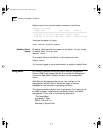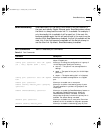
3-16 CHAPTER 3: ACCESSING THE SWITCH
When you define a load-sharing group, you assign a group of ports to
a single, logical port number. To enable or disable a load-sharing group,
use the following commands:
enable sharing <master_port> grouping <portlist>
disable sharing <master_port>
The following example defines a load-sharing group that contains ports
4 through 7, and uses the first port in the group as the master logical
port 4:
enable sharing 4 grouping 4-7
In this example, logical port 4 represents physical ports 4 through 7.
When using load sharing, you should always reference the master
logical port of the load-sharing group (port 4 in the previous example)
when configuring or viewing VLANs. VLANs configured to use other
ports in the load-sharing group will have those ports deleted from the
VLAN when load sharing becomes enabled.
Verifying the Load
Sharing
Configuration
The show port config output screen shows all of the ports that are
involved in load sharing, and the associated master port.
Current Limitations
of Load Sharing
The following describes implementation restrictions that currently apply
to load sharing:
■ The load-sharing group must not participate in a spanning tree. If
the VLANs using the load-sharing group are also members of a
spanning tree, the ports associated with the load-sharing group
must have spanning tree disabled.
■ A port involved in a load-sharing group must not be disabled.
Table 3-7 Port Combinations for the Switch 3800
Load-sharing
Group
1 1 1 1 1 1 1 1 1 1 2 2 2 2 2 2
1 2 3 4 5 6 789012 3 4 5 6 7 8 9 0 1 2 3 4 5
4-port groups x x x x x x x x x x x x x x x x x x x x x x x x
2-port groups x x x x x x x x x x x x x x x x x x x x x x x x
SW3800.BK Page 16 Tuesday, May 5, 1998 5:20 PM


















